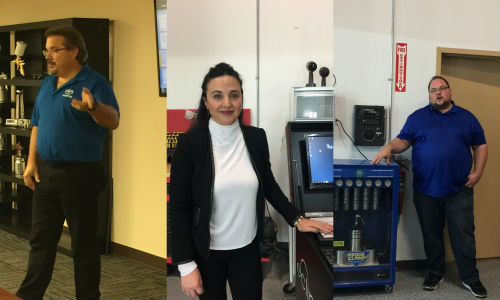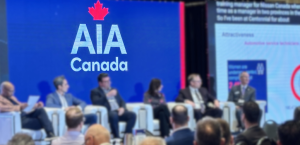By Erin McLaughlin
Edmonton, Alberta — September 28, 2017 — Industry stakeholders in town early for the next meeting of the Canadian Collision Industry Forum (CCIF) had a chance to catch special presentations hosted at Color Company University, the supplier’s training centre in Edmonton.
First, John Martinolich and Rodica Matei of Wedge Clamp showcased various solutions from the company. Martinolich demonstrated the Eclipse electronic measuring system. Some of the advantages put forth by Martinolich included that vehicles don’t need to be level, and the machine can be used from the estimating bay all the way to the rack in the back. The system also comes with free online support for one year and on an annual subscription basis after that point.
Matei showed off the company’s Stat Gun, which she noted is great when painters are laying down metallics. “A lot of people come back to us and say polishing is minimal, or nothing at all after using it,” she said.
Martinolich also demonstrated the company’s new nitrogen generator, the Spray One.
The main focus of the event was a presentation by Paul Stella of Toyota. Stella discussed the company’s Toyota Safety Sense and Lexus Safety System+, noting that these systems are going to be appearing in more and more vehicles.
“By the end of the year, almost all Toyota builds will have Safety Sense as a standard,” he said. Systems can include items such as Parking Assist, Lane Departure, Blind Spot Monitor, Pre-Collision Safety system with pedestrian detection and automatic high beams, to name a few. In other words, the proliferation of safety tech we’ve seen in recent years isn’t slowing down.
The construction of the vehicle itself is also advancing steadily, with high-strength steel now commonplace, and aluminum and carbon fibre becoming increasingly common, even in mass-market vehicles.
Stella highlighted the differences in construction with a video of tests conducted in New Zealand that showed a collision between a 1998 Toyota Corolla and one built in 2015. It dramatically highlighted just how much had changed between one period and another. Put it into its simplest terms, the cabin of the older vehicle was severely comprised. The cabin of the newer vehicle was not. Stella did note that a Canadian 1998 Corolla would have had airbags, which were not mandated at the time in New Zealand. You can check out the video for yourself in the player below.
Stella also discussed Toyota’s certification program, noting that the company’s goal is to raise the standard. There are 41 processes that Toyota audits. Of these, 12 are mandatory. Of the 29 remaining, your facility must qualify on at least 25.
Some of the items are exactly what you would expect, such as having a MIG welder and employing I-CAR certified technicians. Some, however, aren’t directly related to the repair process, but are focused more on health and safety, for example having an eye wash station and clearly labeling all cleaning equipment.
Watch for more reports from CCIF Edmonton on collisionrepairmag.com!






































